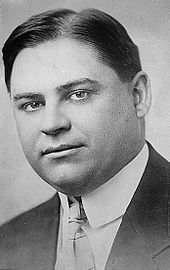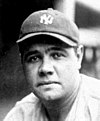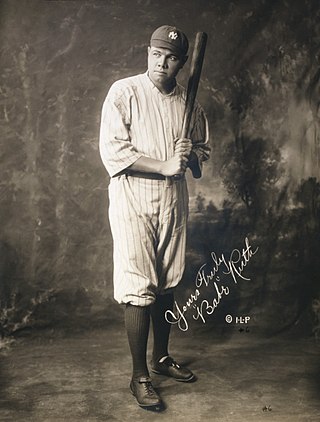
George Herman "Babe" Ruth was an American professional baseball player whose career in Major League Baseball (MLB) spanned 22 seasons, from 1914 through 1935. Nicknamed "the Bambino" and "the Sultan of Swat", he began his MLB career as a star left-handed pitcher for the Boston Red Sox, but achieved his greatest fame as a slugging outfielder for the New York Yankees. Ruth is regarded as one of the greatest sports heroes in American culture and is considered by many to be the greatest baseball player of all time. In 1936, Ruth was elected into the Baseball Hall of Fame as one of its "first five" inaugural members.

The Boston Red Sox are an American professional baseball team based in Boston. The Red Sox compete in Major League Baseball (MLB) as a member club of the American League (AL) East Division. Founded in 1901 as one of the American League's eight charter franchises, the team's home ballpark has been Fenway Park since 1912. The "Red Sox" name was chosen by the team owner, John I. Taylor, c. 1908, following the lead of previous teams that had been known as the "Boston Red Stockings", including the Boston Braves. The team has won nine World Series championships, tied for the third-most of any MLB team, and has played in 13 World Series. Their most recent World Series appearance and win was in 2018. In addition, they won the 1904 American League pennant, but were not able to defend their 1903 World Series championship when the New York Giants refused to participate in the 1904 World Series.

Harry Herbert Frazee was an American theatrical agent, producer, and director, and owner of Major League Baseball's Boston Red Sox from 1916 to 1923. He is well known for selling Babe Ruth to the New York Yankees, which started the alleged Curse of the Bambino.

The 1986 World Series was the championship series of Major League Baseball's (MLB) 1986 season. The 83rd edition of the World Series, it was a best-of-seven playoff played between the National League (NL) champion New York Mets and the American League (AL) champion Boston Red Sox. The Mets won the series four games to three to claim their second World Series title and first since 1969.

The 2003 American League Championship Series (ALCS) was played between the Boston Red Sox and the New York Yankees from October 8 to 16, 2003. The Yankees won the series four games to three to advance to the World Series, where they lost in six games to the National League champion Florida Marlins.
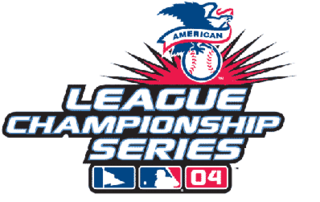
The 2004 American League Championship Series was the Major League Baseball playoff series deciding the 2004 season American League champion earning the privilege to play in the 2004 World Series. A rematch of the 2003 American League Championship Series, it was played between the Boston Red Sox, who had won the AL wild card and defeated the Anaheim Angels in the American League Division Series, and the New York Yankees, who had won the AL East with the best record in the AL and defeated the Minnesota Twins. The Red Sox became the first team in MLB history to come back from a 3–0 series deficit to win a best-of-seven series. Prior to the 2004 ALCS, no MLB team had so much as forced a Game 7 under those circumstances – and only one team since 2004 has been able to do so.

The 2004 World Series was the championship series of Major League Baseball's (MLB) 2004 season. The 100th edition of the World Series, it was a best-of-seven playoff between the American League (AL) champion Boston Red Sox and the National League (NL) champion St. Louis Cardinals; the Red Sox beat the Cardinals in four games. The series was played from October 23 to 27, 2004, at Fenway Park and Busch Memorial Stadium, broadcast on Fox, and watched by an average of just under 25.5 million viewers. The Red Sox's World Series championship was their first since 1918, ending the Curse of the Bambino.

The 1918 World Series was the championship series in Major League Baseball for the 1918 season. The 15th edition of the World Series, it matched the American League champion Boston Red Sox against the National League champion Chicago Cubs. The Red Sox beat the Cubs four games to two. The Series victory for the Red Sox was their fifth in five tries, going back to 1903. The Red Sox scored only nine runs in the entire Series, the fewest runs by the winning team in World Series history. Along with the 1906 and 1907 World Series, the 1918 World Series is one of only three Fall Classics where neither team hit a home run.

The Yankees–Red Sox rivalry is a Major League Baseball (MLB) rivalry between the New York Yankees and the Boston Red Sox. Both teams have competed in MLB's American League (AL) for over 120 seasons and have since developed what is arguably the fiercest rivalry in all of American sports. In 1919, Red Sox owner Harry Frazee sold star player Babe Ruth to the Yankees, which was followed by an 86-year period in which the Red Sox did not win a World Series. This led to the popularization of a superstition known as the "Curse of the Bambino," which was one of the most well-known aspects of the rivalry.

Fever Pitch is a 2005 American romantic comedy-drama film directed by the Farrelly brothers. It stars Drew Barrymore and Jimmy Fallon and is a remake of the British 1997 film of the same title. Nick Hornby, who had written the original 1992 book and the 1997 screenplay adaptation, acted as an executive producer for the American remake.
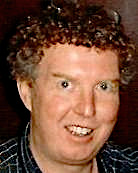
Dan Shaughnessy is an American sports writer. He has covered the Boston Red Sox for The Boston Globe since 1981. In 2016, he was given the J. G. Taylor Spink Award by the Baseball Hall of Fame. Shaughnessy is often referred to by his nickname "Shank," given by the 1980s Boston Celtics team for the often unflattering and critical nature of his articles.
The Curse of the Black Sox (1919–2005) was a superstition or "scapegoat" cited as one reason for the failure of the Chicago White Sox to win the World Series from 1917 until 2005. As with other supposed baseball curses, such as the crosstown Chicago Cubs' Curse of the Billy Goat (1945–2016), or the Boston Red Sox' Curse of the Bambino (1918–2004), these "curses" have been publicized by the popular media over the course of time.
The following are the baseball events of the year 1927 throughout the world.
The history of the Boston Red Sox begins in 1901, as one of the original franchises of the American League.

The 1999 American League Championship Series (ALCS) was a matchup between the East Division Champion New York Yankees (98–64) and the Wild Card Boston Red Sox (94–68). The Yankees had advanced to the Series after sweeping the West Division Champion Texas Rangers in the AL Division Series for the second consecutive year, and the Red Sox advanced by beating the Central Division Champion Cleveland Indians three games to two. The Yankees won the series, 4-1. They won their 36th American League pennant and went on to win the World Series against the Atlanta Braves.

The 2004 Boston Red Sox season was the 104th season in the franchise's Major League Baseball history. Managed by Terry Francona, the Red Sox finished with a 98–64 record, three games behind the New York Yankees in the American League East. The Red Sox qualified for the postseason as the AL wild card, swept the Anaheim Angels in the ALDS, and faced the Yankees in the ALCS for the second straight year. After losing the first three games to the Yankees and trailing in the ninth inning of the fourth game, the Red Sox became the first team in major league history to come back from a three-game postseason deficit, defeating the Yankees in seven games. The Red Sox then swept the St. Louis Cardinals in the World Series, capturing their first championship since 1918.

The 1978 American League East tie-breaker game was a one-game extension to Major League Baseball's (MLB) 1978 regular season. The game was played at Fenway Park in Boston on the afternoon of Monday, October 2 between the rival New York Yankees and Boston Red Sox to determine the winner of the American League's (AL) East Division.
Bill Buckner's 1986 World Series error was a baseball play that occurred in Game 6 of the 1986 World Series on October 25, 1986, at Shea Stadium in Queens, New York.
The 1986 Major League Baseball postseason was the playoff tournament of Major League Baseball for the 1986 season. The winners of each division advance to the postseason and face each other in a League Championship Series to determine the pennant winners that face each other in the World Series.
The 2004 Major League Baseball postseason was the playoff tournament of Major League Baseball for the 2004 season. The winners of the League Division Series would move on to the League Championship Series to determine the pennant winners that face each other in the World Series.

